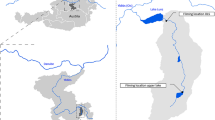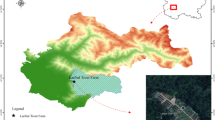Abstract
Patagonian toothfish Dissostichus eleginoides Smitt 1898, is an important commercially targeted Notothenioid species in South-Atlantic waters. In this study we aimed to clarify several aspects of reproductive biology of Patagonian toothfish in the Falkland Islands waters. Histological examination of female gonads indicates that with the beginning of maturation females maintain at least two populations of oocytes, suggesting that toothfish requires up to two years for oocytes development. Females become mature at an average size of 79.1 cm indicating a decrease of first maturity size if toothfish females in the Falkland Island waters. The majority of females spawn at the size from 101 to 130 cm total length. Distribution of reproductive phases shows an increase of females at developing stage in December and March prior to the spawning peaks in May and August respectively. However, the majority of the toothfish population consist of non-spawning individuals remaining in regressing phase (55.8 to 85.6%) including the spawning period. The skip-spawning for toothfish has been defined as reabsorbing non-reproductive and resting types. The abbreviation of oocytes development in the gonads was observed from 1 to 22.1% of females which omitted the spawning season. Most likely females which remain in the spawning area have the opportunity to spawn more often, whereas females which undergo foraging migration toward Northern parts of the Falklands waters return to the spawning ground less often. Females remain Northern area longer to accumulate necessary amount of energy. This hypnotise is supported by the presence of females in immature, developing and regressing phase throughout surrounding Falkland Islands waters. Presence of post-spawning females in regressing stage throughout the Falklands waters suggest that toothfish may undertake irregular spawning/foraging migration when favourable for spawning condition occur.






Similar content being viewed by others
References
Agnew DJ, Heaps L, Jones C, Watson A, Berkieta K, Pearce J (1999) Depth distribution and spawning pattern of Dissostichus eleginoides at South Georgia. CCAMLR Science 6:19–36
Alexeev FE, Alexeeva EI, Zaharov AN (1991) Viteloginesis, character of spawning and maturity stages of gonads developing by macrourus Coryphaenoides rupestris in North Atlantic. Voprosy ichtiologii 31(6):917–927
Alexeeva EI, Alexeev FE, Konstantinov VV, Boronin BA (1992) Reproductive biology of Macrourus carinatus, M. whitsoni, Coelorinchus fasciatus (Macrouridae) and Patagonotothen guentheri shagensis (Nototheniidae) and functional structure of area of M.carinatus. Voprosy ichtiologii 32(4):105–115
Arana P (2009) Reproductive aspect of the Patagonian toothfish (Dissostichus eleginoides) off southern Chile. Lat Am J Aquat Res 37(3):381–394
Brickle P, Laptikhovsky V, Arkhipkin A, Portela J (2006) Reproductive biology of Patagonotothen ramsay (Regan, 1913) (Pisces: Nototheniidae) around the Falkland Islands. Polar Biol 29:570–580
Brigden KE, Marshall CT, Scott BE, Young EF, Brickle P (2017) Interannual variability in reproductive traits of the Patagonian toothfish Dissostichus eleginoides around the sub-Antarctic island of South Georgia. J Fish Biol 91:278–301
Brown J (2009) PhD thesis on the ecology and life history of Patagonian toothfish (Dissostichus eleginoides)
Brown J, Brickle P, Scott BE (2013) Investigating the movements and behavior of Patagonian toothfish (Dissostichus eleginoides Smitt, 1898) around the Falkland Islands using satellite linked archival tags. J Exp Mar Biol Ecol 443:65–74
Brown-Peterson NJ, Wyanski DM, Saborido-Rey F, Macewicz BJ, Lowerre-Barbieri SK (2011) A standardized terminology for describing reproductive development in fishes. Marine and Coastal Fisheries: Dynamics, Management, and Ecosystem Science [online serial] 3(1):52–70
Calvo J, Morriconi E, Rae GA (1999) Reproductive biology of the icefish Champsocephalus esox (Günther, 1861) (Channichthydae). Antarct Sci 11(2):140–149
Chapman BB, Hulthen K, Brodersen J, Nilson PA, Skov C, Hansson L-A, Broenmark C (2012) Partial migration in fishes: causes and consequences. J Fish Biol 81(2):456–478
Collins MA, Brickle P, Brown J, Belchier M (2010) The Patagonian Toothfish: Biology, Ecology and Fishery. In: Lesser M (ed) Adv Mar Biol - 58. Academic Press, Burlington, pp 227–300
Eastman JT, DeVries AL (2000) Aspect of body size and gonadal histology in the Antarctic toothfish, Dissostichus mawsoni, from McMurdo sound, Antarctica. Polar Biol 23(3):189–195
Everson I (1970) Reproduction in Notothenia neglecta Nybelin. British Antarctic Survey Bulletin 23:81–92
Everson I (1994) Timescale of ovarian maturation in Notothenia coriiceps: evidence for a prolonged adolescent phase. J Fish Biol 44:997–1004
Everson I, Murray A (1999) Size at sexual maturity of Patagonian toothfish (Dissostichus eleginoides). CCAMLR Science 6:37–46
Everson I, Kock K-H, Campbell S, Parkes G, Cielniaszek D, Szlakowski J (1991) Reproduction in the Mackrel icefish (Champsocephalus gunnari) at South Georgia. Document WG-FSA-91/7, CCAMLR, Hobart
Ganias K (2012) Thirty years of using the postovulatory follicles method: overview, problems and alternatives. Fish Res 117– 118:63–74
Ganias K, Nunes C, Stratoudakis Y (2007) Degeneration of postovulartory follicles in Sardina pilchardus: structural changes and factors affecting resorption. Fish Bull 105:131–139
Hunter JR, Macewicz BJ (1985) Measurement of spawning frequency in multiple spawning fishes. NOAA Technical Report NMFS 36:79–94
Jørgensen C, Ernande B, Fiksen Ø, Dieckmann U (2006) The logic of skipped spawning in fish. Can J Fish Aquat Sci 63(1):200–211
Kock K-H, Kellermann A (1991) Reproduction in Antarctic notothenioid fish. Antarct Sci 3:125–150
Laptikhovsky V, Brickle P (2005) The Patagonian toothfish fishery in the Falkland Islands’ waters. Fish Res 74:11–23
Laptikhovsky V, Arkhipkin A, Brickle P (2006) Distribution and reproduction of the Patagonian toothfish Dissostichus eleginoides Smitt around the Falkland Islands. J Fish Biol 68:849–861
Livingston ME, Vignaux M, Schofield KA (1997) Estimating the annual proportion of nonspawning adults in New Zealand hoki. Fish Bull 95:99–113
Loher T, Seitz A (2008) Characterization of active spawning season and depth for eastern Pacific halibut (Hippoglossus stenolepis), and evidence of probable skipped spawning. J Northwest Atl Fish Sci 41:23–36
Lowerre-Barbieri SK, Brown-Peterson NJ, Murua H, Tomkiewicz J, Wyanski DM, Saborido-Rey F (2011) Emerging issues and methodological advances in fisheries reproductive biology. Marine and coastal fisheries: dynamics, Management, and Ecosystem Science [online serial] 3:176–189
Machhi GJ, Barrera-Oro E (1995) Histological study on the ovarian development of mackerel icefish (Champsocephalus Gunnari) from the South Georgia Islands. CCAMLR Science 2:35–49
Marlow TR, Agnew DJ, Purves MG (2003) Movement and growth of tagged Dissostichus eleginoides around South Georgia and shag rocks (subarea 48.3). CCAMLR Science 10:101–111
Marshall CT, Needle CL, Thorsen A, Kjesbu OS, Yaragina NA (2006) Systematic bias in estimates of reproductive potential of an Atlantic cod (Gadus morhua) stock: implications for stockrecruit theory and management. Can J Fish Aquat Sci 63(5):980–994
Murua H, Motos L (2000) Reproductive biology of roughhead grenadier (Macrourus berglax Lacepède, 1801) (Pisces, Macrouridae), in Northwest Atlantic waters. Sarsia 85:393–402
Nevinski MM, Kozlov AN (2002) Fecundity of Patagonian toothfish around South Georgia Island (Southern Atlantic). Voprosy ihtyologii 42(4):571–573
Pilling GM, Purves MG, Daw TM, Agnew DA, Xavier JC (2001) The stomach contents of Patagonian toothfish around South Georgia (South Atlantic). J Fish Bio 59(5):1370–1384
Pyanova SV (2006) Osobennosti sostoyaniya yaichnikov klykachey yugo-vostochnoy atlantiki v prednerestovy period. Ecologiya v menyayushemsya mire Materialy cinferencii molodyh uchenyh RAN In Russian 193–196
Pyanova SV and Petrov AF (2010) Analysis of maturity of Antarctic toothfish in the Amundsen Sea in the summer period. Problems of Fisheries Vol 11 №4 (44):831–842
Rideout RM (1999) Aspects of the reproductive cycle of Atlantic cod, Gadus morhua L., from inshore Newfoundland. MSc thesis, Memorial University of Newfoundland, St. John’s, pp 131
Rideout RM, Tomkiewicz J (2011) Skipped spawning in fishes: more common than you might think. Marine and coastal fisheries: dynamics, Management, and Ecosystem Science [online serial] 3:176–189
Rideout RM, Rose GA, Burton MPM (2005) Skipped spawning in female iteroparous fishes. Fish Fish 6:50–72
Rideout RM, Morgan MJ, Lilly GR (2006) Variation in the frequency of skipped spawning in Atlantic cod (Gadus morhua) off Newfoundland and Labrador. ICES J Mar Sci 63:1101–1110
Rochet MJ, Cornillon PA, Sabatier R, Pontier D (2000) Comparative analysis of phylogenetic and fishing effects in life history patterns of teleost fishes. Oikos 91:255–270
Skjæraasena JE, Nash RDM, Korsbrekke K, Fonn M, Nilsen T, Kennedy J, Nedreaas KH, Thorsen A, Witthames PR, Geffena AJ, Høiea H, Kjesbu OS (2012) Frequent skipped spawning in the world’s largest cod population. PNAS 109(23):8995–8999
Trippel EA (1999) Estimation of stock reproductive potential: history and challenges for Canadian Atlantic gadoid stock assessments. J Northw Atl FishSci 25:61–81
Williams R and Lamb T (2002) Behaviour of Dissostichus eleginoides fitted with archival tags at Heard Island: preliminary results. Document WG-FSA-02/60. CCAMLR, Hobart
Witthames PR, Greer Walker M (1995) Determination of fecundity and oocyteatresia in sole (Solea solea) (Pisces) from the channel, the North Sea and the Irish Sea. Aquat Living Resour 8:91–109
Witthames PR, Thorsen A, Kjesbu OS (2010) The fate of vitellogenic follicles in experimentally monitored Atlantic cod Gadus morhua (L.): application to stock assessment. Fish Res 104:24–37
Electronic references
QGIS Development Team (2014) QGIS Geographic Information System. Open Source Geospatial Foundation. URL http://qgis.osgeo.org
Froese R and Pauly D (Eds) (2009) FishBase. www.fishbase.org, version (09/2009)
Torrejon-Magallanes J (2014) sizeMat: an R package to estimate size at sexual maturity. CRAN R-Project, https://cran.r-project.org/web/packages/sizeMat/vignettes/sizeMat.html#load-data
Acknowledgments
We would like to thank Falkland Islands Government Fisheries Department and the Consolidated Fisheries Limited for supporting this work, also the crew of CFL Gambler for help during samples collection. We would like to thank fisheries observers of the Fisheries Department for collecting the biological data, especially A. Monllor and E. Visauta Girbau for help in processing the histological samples. We also would like to thank V. Laptikhovsky, P.R. Witthames and H. Murua for consultation on histological images and helpful advice, and Paul Brewin for work on this manuscript and valuable additions.
Author information
Authors and Affiliations
Corresponding author
Ethics declarations
Conflict of interest
The author Elena Boucher declares that she has no conflict of interest.
Ethical approval
All applicable international, national, and/or institutional guidelines for care and use of animals were followed.
Rights and permissions
About this article
Cite this article
Boucher, E. Disentangling reproductive biology of the Patagonian toothfish Dissostichus eleginoides: skipped vs obligatory annual spawning, foraging migration vs residential life style. Environ Biol Fish 101, 1343–1356 (2018). https://doi.org/10.1007/s10641-018-0781-8
Received:
Accepted:
Published:
Issue Date:
DOI: https://doi.org/10.1007/s10641-018-0781-8




